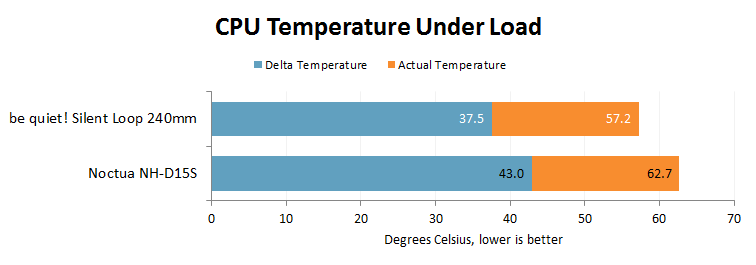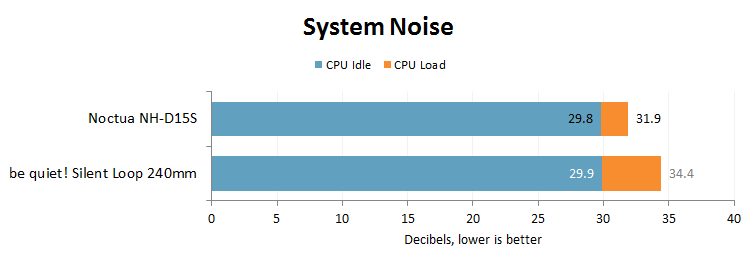Test Methodology and Performance
Comparison Coolers |
||||
|---|---|---|---|---|
| Cooler | HEXUS Review | Reviewed Price | Warranty | Product Page |
| be quiet! Silent Loop 240mm | October 2016 | £115 | 3 Years | bequiet.com |
| Noctua NH-D15S | N/A | £70 | 6 Years | noctua.at |
HEXUS CPU Cooler Test Bench |
||
|---|---|---|
| Hardware Components | Product Page | |
| Processor | Intel Core i7-6700K (overclocked to 4.4GHz) | intel.com |
| CPU Cooler | Noctua NH-D15S | noctua.at |
| Motherboard | Asus Z170 Pro | asus.com |
| Memory | Crucial Ballistix Sport LT 32GB (2x16GB) DDR4-2400 | crucial.com |
| Power Supply | be quiet! Dark Power Pro 11 850W | bequiet.com |
| Primary Storage | 256GB Samsung 950 Pro | samsung.com |
| Secondary Storage | 512GB SK hynix Canvas SC300 | skhynix.com |
| Chassis | Fractal Design Define R5 Windowed | fractal-design.com |
| Monitor | Philips Brilliance 4K Ultra HD LED (288P6LJEB/00) | philips.co.uk |
| Operating system | Windows 10 (64-bit) | microsoft.com |
Benchmark Process
Our updated test platform includes a quad-core Intel Core i7-6700K processor overclocked to 4.4GHz across all cores and 32GB of Crucial Ballistix Sport LT DDR4 memory set to run at 2,400MHz using the built-in XMP profile.
To get a feel for how the above coolers compare, CPU voltage is upped to an above-average 1.3V and temperature is logged while a large 4K video clip is encoded in multiple passes using the freeware HandBrake utility. The workload tasks all four cores/eight threads for a prolonged period and, in order to provide a stabilised reading, we then calculate the average temperature across all four cores from the last few minutes of encoding.
Actual CPU temperature is recorded and we also graph the delta temperature - that's CPU temperature minus ambient temperature. Last but not least, to give you an idea of cooler acoustics, we use a PCE-318 noise meter to measure overall system noise in both idle and load states.
Notes
Our Fractal Design Define R5 chassis is set to run with its two stocks fans - a 140mm Silent Series R2 front intake and a 140mm Silent Series R2 rear exhaust - both of which are set to low speed via the integrated fan hub. All CPU cooler fans are set to a 'silent' PWM profile from within the Asus BIOS, and when testing liquid coolers the pump is connected to the motherboard's dedicated water-pump header.
When a radiator is installed, the relevant top ModuVents are removed from the Fractal Design Define R5 chassis, and any fans connected to the radiator are configured as per the manufacturer's recommendation. In the case of the be quiet! Silent Loop 240mm, the dual fans are positioned to push air through the radiator and up through the roof of the chassis.
Performance

We're starting afresh on our new test platform by comparing our favourite air cooler - Noctua's NH-D15S - to the Silent Loop 240mm. We'd expect a good-sized radiator to take the lead, and the be quiet! solution does just that by reducing actual temperature under load by roughly nine per cent. Not bad going, but also no surprise.

Here's where things get interesting. In the past, we've found all-in-one liquid coolers to be noisier than the Noctua when our test platform is idling due to pump noise and low-quality fans. That isn't the case with the Silent Loop 240mm, as the cooler can barely be heard when idle and in unless the room is deathly silent you'd struggle to know it's turned on.
The noise gap under load does increase, however the difference isn't huge and the Silent Loop's higher reading can, in part, be attributed to the chassis' top Modu Vents being removed. Noctua's NH-D15S still stands out as the preferred choice for an ultra-quiet PC, but be quiet!'s Silent Loop 240mm is a useful alternative.









